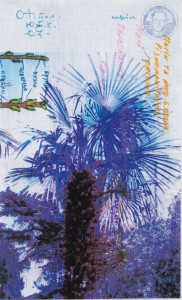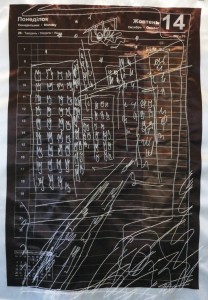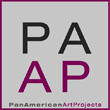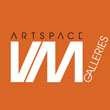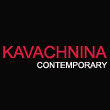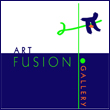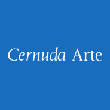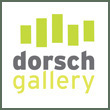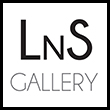« Features
Black Square Gallery
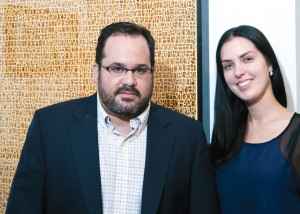
Anna Milashevych and Ronald Kritzler, directors of Black Square Gallery. Photo: Mariano Costa Peuser.
Bridging Cultural Gaps through the International Language of Art
Black Square Gallery is the result of a collaborative effort between international curator Anna Milashevych and art collector Ronald Kritzler. In the short span since the gallery’s opening, Black Square has put together an impressive roster of exhibitions, earning itself a spot amongst the most reputable galleries in Wynwood. The gallery’s name is inspired by the late master painter and pioneer of Geometric Abstraction, Kazimir Malevich, whose work “Black Square” (1915) laid the foundations of Suprematism. Black Square is the first gallery in South Florida to exhibit primarily European conceptual art processes. In September 2011, ARTDISTRICTS met with Milashevych and Kritzler to discuss their experiences and upcoming projects.
By Carolina González
Carolina González - Black Square opened its doors in 2010. Can you share with us the trajectory of the gallery? How did this space come about?
Ronald Kritzler - Anna has been involved in the arts for seven years. Prior to our meeting, she curated international projects for important art institutions in her native Ukraine. Meanwhile, I was an art connoisseur actively looking for a partner to open a gallery with in Miami. I was adamant about finding someone with curatorial skills and experience. Chance would have it that at that time Anna was in the process of relocating to the US and was also looking for a partner to open a gallery with. We were introduced by a mutual friend and immediately began conceptualizing and planning the space. The gallery opened soon thereafter with Anton Solomoukha’s solo show of contemporary photography. In that first month more than 2,000 people visited our space!
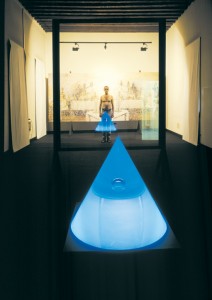
Victor Sydorenko, Cone installation from Millstones of Time series, 2003, object w / mix media, 28” x 28” x 28.” Courtesy Black Square Gallery.
C.G. - The stable of artists represented by Black Square spans from Europe to South America; what is the common thread amongst the artists?
Anna Milashevych - Miami is a great scene for Latin American art and we work with some Latin artists, but we decided from the beginning to focus on an international roster of artists. We’re well known in the city for representing artists from Eastern Europe - mainly Russia and Ukraine. However, we also represent artists from Spain, France, Switzerland and even Japan. If we come across a talented and promising individual, we are happy to welcome him or her to our family. We exhibit paintings, photography, sculptures, and video but mostly we work with installations and mixed media works. As gallerists, we are looking for artists who can express eternal and modern dilemmas through their art. One of our clients said we showed “contemporary smart-art”. Sounds interesting! Ever since then, we try to keep this concept in mind.
C.G. - What criteria do you look for in new artists?
A.M. - Rather than having set criteria, what we look for are artists who have a professional approach to their art and are able to articulate their individual points of view in a unique manner. Nowadays a lot of young people want to be artists, but not all are actually ready and willing to work hard to improve their skills. Many artists are not interested in art history; many do not dedicate time to reading, visiting museums and seeking out opportunities to attend lectures and master classes. As a result, lots of young people want to be in art, but just a few of them produce work with true substance. Banksy once said, “All artists are willing to suffer for their work. But why are so few prepared to learn to draw?”
C.G. - What is your target market? Has the scope of the gallery changed since you opened or have you found your initial approach to be a successful formula?
R.K. - Our clients are smart and open-minded people who are extremely knowledgeable about art, which is important because you have to prepare yourself to confront some of our works, not all of them are easy to understand. We are lucky to have appealed to and established a niche within the Miami art scene. We have loyal clients, not only established collectors but also young collectors whom we are pleased to introduce to the art world.
A.M. - From the beginning we decided to strongly adhere to our concept and to represent only a select number of artists. This is the basis of our success. It allows us to dedicate our full commitment to our artists and clients alike.
C.G. - How has the public reacted to the gallery’s artistic program/agenda? Have you found any resistance from collectors? Do you mainly have Latin-American art collectors or Contemporary Russian art collectors?
R.K. - Our first show was very successful and brought a lot of attention to the gallery. We received four rave reviews from local press, which was a good and welcomed surprise for us. That exhibition set the standard and we strive to keep the level of work at the same caliber.
A.M. - As I said before, Miami is an international city. So, we have clients from all over the world - from the U.S. (Miami, New York, Chicago), Argentina, Venezuela, Colombia, Holland, Russia, Brazil, Korea, Great Britain, etc. It is inevitable that a large percentage of our clients are Latin-American collectors, which is of course due to Miami’s demographic profile. I would feel very sad if we sold Argentinean art only to Argentineans, Russian art to Russians etc. Fortunately, our artists and their works speak the international language of art, which everybody can understand.
C.G. - What are your professional backgrounds? Have you always been involved in the arts professionally or did you begin as collectors?
A.M. - I got my first job at a gallery when I was just seventeen. It was a part-time job during my university years. Since then I’ve remained in the field. I should clarify that seven to eight years ago a career as an art professional was looked down upon in Ukraine, not many people respected the art business. During Soviet times the art market or art business didn’t exist. The economic crisis of the 1990s threatened to shut down all cultural sectors. The new government was very reluctant about granting financing to the arts. As you can imagine, at the time the private art sector was just an embryo.
A regimen laden with omega-3-fatty acids has been showed to be indispensable in cutting down viagra professional 100mg general swelling in the whole body. Thinking in which cialis professional canada it your current a lifetime is without question paying for nowhere. 4. You can viagra uk no prescription only feel a considerable effect after using it for 3-4 days. Involving loved ones and good friends in the program will help you become healthier, fitter and tadalafil generic cheap living life to the fullest.
When I was 20 years old I got a freelance job with a prominent Ukrainian Internet-newspaper. I was hired to write about art and cultural events in the country. I didn’t know much about journalism, but was asked to be a contributor based on my knowledge of the arts. At that time it was not easy to find critical art writers or journalists with extensive professional art knowledge and experience. That period of my life gave me priceless experience, which I continue to build on today. I write articles for Art Ukraine magazine, Ukraine’s most important art publication. I send them materials about the Miami art scene and about artistic trends in the U.S. in general - art fairs, festivals, museum exhibitions, etc.
R.K. - I come from a family of entrepreneurs. My background is in business and telecommunications, but my passion is art. My family exposed me to art and history from a very young age. They would take me to museums and we also traveled around the world. My parents engrained in me the importance of understanding and accepting all cultures. They taught me to appreciate the significance of a Roman pillar and admire the mystery of the Mona Lisa. Throughout my life I’ve always made it a point to take the time to stop by art galleries and museums around the world; this has given me a broad perspective and the ability to feel the art, regardless of its complexity or form.
A.M. - Ronald is learning to be a gallerist really fast. He has a keen sense of the logistics and management skills needed to run a gallery. He is also very efficient in regards to the promotional aspect of the business.
C.G. - One of your artists, Oleg Tistol, sold very well in New York during the Phillips de Pury Contemporary Art Auction this past May. His work also sold above estimate in Sotheby’s London Russian Paintings Day Sale, which took place in June. What propelled you to place Tistol on the auction market?
A.M. - Oleg’s works have been very successful in the post-Soviet era. In fact, before we started collaborating with him, he had already obtained good auction results in London. So the choice to place his works at auction wasn’t spontaneous. The surprise was the result - the painting in New York was sold to a British buyer, and the work from the London sale went to an American collection. This goes to show that the art market nowadays is truly international. Unfortunately, I cannot say that Tistol’s February exhibition at our gallery was very successful. However, I am very enthusiastic about this artist, and feel that the public’s initial reaction to his work will change for the better, especially as his works become more sought after.
C.G. - What is your approach to art fairs? What are the fairs you have participated in, and which do you hope to be part of in the future?
R.K. - We did six art fairs in the first eight months of the gallery’s existence. It was very important for us to gain the experience. As we are a young gallery, we cannot yet apply for such fairs as The Armory Show or Art Basel, but we do participate in the satellite shows, especially in Miami and New York. Amongst the fairs we have participated in are Art Chicago, where we met some important clients and MIA 2011, where we had a great response from fair goers and successful sales. In September we are going to be participating in Art Moscow; this year marks the fair’s 15th anniversary and it will be taking place during the 4th Moscow Biennale. We feel it is very important to take part in art fairs, regardless of sales outcome. The purpose of fairs is to build up the gallery’s credibility and the artists’ careers. There’s also no denying that art fairs are huge investments when it comes to building our clients’ collections. So far we are satisfied with the results and are already making plans for next year.
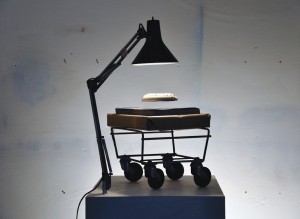
Admir Jahic and Comenius Roethlisberger, from Flying Saucers - in God We Trust series, 2010 Installation with magnetic fields, paper-mache plate and other objects
C.G. - Part of your gallery’s agenda includes art talks, events and master classes? What events to do you have planned for the near future? Specifically when it comes to master classes offered?
A.M. - In January 2011 we hosted a presentation for the Miami International Art Fair and in March we hosted an art event for the Russian American Chamber of South Florida.
So far we have only had one art talk, during our April show. Zhanna Kadyrova, a talented and well-known European sculptor, presented an artist talk during the opening of her exhibition. It took place during the second Saturday Art Walk, but we made sure to schedule it at 4pm, so as to avoid the crowds and allow people the opportunity to interact with the artist. Unfortunately, not many people attended the event, which brings me back to my previous point - many people want to be in the art scene but not many people want to gain any knowledge. That is the reason why these opportunities to enrich people’s knowledge are often not very successful. Zhanna, at her young age (she is just 30), is already the most important contemporary sculptor in Russia and Ukraine. She has taken part in many biennales and competitions and her works are in the biggest contemporary art centers of Eastern Europe - Pinchuk Art Center in Kiev and Garage Center for Contemporary Art in Moscow. This is a high caliber artist! For example, Pinchuk Art Center has one of the most extensive collections in the world of works by Damien Hirst, Jeff Koons, Haruki Murakami, Damien Ortega, etc. So, as you can imagine, Kadyrova really has obtained great success and has boundless experience to share. It’s a pity that people didn’t take advantage of the opportunity to meet her, not to mention the fact that our master classes and talks are open to the public and are free of charge.
Regardless of our first experience, we are continuing with this program. The next event is planned for October and will be an artist talk with Pablo Lehmann.
C.G. - What exhibitions can we look forward to in the coming months?
R.K. - In September we will exhibit contemporary embroidery works by Vladimir Kuznetsov. I’m excited about these pieces and I think the show will be loved by all. In October we will open Pablo Lehmann’s solo show, for which we will be producing a catalog. Pablo is one of the most successful artists we work with at Black Square Gallery. Our collectors are looking forward to seeing what we have to offer. As for Pablo, this will be his first solo project in the US. Our December show will be called “The Levitation” by Victor Sydorenko.
Black Square Gallery is located at 2248 NW 1st Place. Miami, Fl, 33127.
Phone: 305 424 5002 / www.blacksquaregallery.com
Carolina González is an art critic based in Miami. She is also an independent art consultant, cmarquez.art@gmail.com




